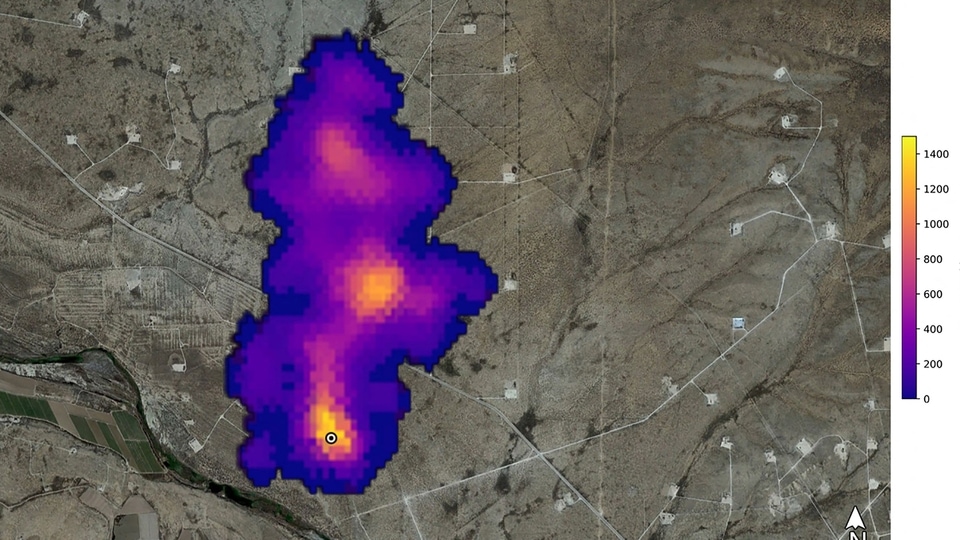Exclusive Satellite Images Show Near Real-Time Methane Emissions
During COP27 we’re posting high-resolution images of a methane clouds to highlight how common — and damaging — releases of the potent greenhouse gas are.






 View all Images
View all ImagesAll through COP27, Bloomberg Green will exclusively publish new satellite images of methane releases around the world, in collaboration with emissions monitoring firm GHGSat Inc. Scientists say reducing the emissions of methane, which has 84 times the warming power of carbon dioxide during its first two decades in the atmosphere, is one of the fastest and cheapest ways to cool the planet.
Near Kirtland, New Mexico, USA, Nov. 6, 1:48 pm local time
A GHGSat satellite observed methane emissions near a coal mine Sunday afternoon in New Mexico that the emissions monitoring firm said was coming from a mine vent. The company estimated the release was spewing at a rate of 440.4 kilograms per hour.
Operational coal mines often vent methane to reduce the risk of explosion. Closed or abandoned coal mines can leak methane for years if they aren't properly sealed.
Coal mines releasing methane account for about 30% of the total emissions of the potent greenhouse gas coming from the energy sector. Halting intentional venting of methane and accidental leaks from coal mines and oil and gas infrastructure is viewed by scientists as some of the lowest hanging fruit in the fight against climate change.
GHGSat said they first detected emissions from the site through a demonstrator satellite in 2016. An official with the New Mexico Environment Department said Westmoreland Mining LLC is the operator of the facility near the plume. An official at Westmoreland didn't immediately respond to a request for comment after normal business hours.
Near Lucknow, India, Nov. 5, 1:28 pm local time
The satellite image was taken on Saturday and shows a plume of methane that GHGSat attributed to a landfill in India. The estimated emissions rate was 1,328 kilograms per hour of methane. Landfills tend to be persistent emitters, according to the Montreal-based company.
The detection highlights how piles of garbage — which generate the potent greenhouse gas when organic material like food scraps break down in the absence of oxygen — are triggering some of the world's strongest and most persistent methane emissions. Landfills and wastewater are responsible for about 20% of the methane emissions generated from human activity.
Failing to curb releases from the waste sector could derail global climate goals. Diverting food scraps and other organics before they enter a landfill is crucial to limiting future emissions. The impact of legacy dumps can be mitigated through aerating piles of trash and gas capture systems.
Near Daqing, China, Nov. 4 at 1:15pm local time
On Friday a satellite identified six methane releases in northeast China near the Daqing oilfield, according to GHGSat. Estimated emissions rates ranged between 446 and 884 kilograms per hour and the cumulative rate was 4,477 kilograms an hour. If the releases lasted for an hour at that rate they would have the same short-term climate impact as the annual emissions from about 81 US cars.
Methane is the primary component of natural gas and responsible for about 30% of the Earth's warming. Leaks can occur during extraction and transport of the fossil fuel, but methane is also routinely generated as a byproduct of oil and coal production and if operators don't have infrastructure to get the gas to market they may release it into the atmosphere. The International Energy Agency has called for oil and gas operators to halt all non-emergency methane venting.
The detections highlight the rapidly expanding ability of satellites to identify and track methane almost anywhere in the world that is driving a new era of climate transparency in which greenhouse gases will be quantified and attributed in near real-time to individual assets and companies.
More companies and institutions are launching multi-spectral satellites that can detect methane's unique signature. GHGSat has six satellites in orbit now dedicated to monitoring industrial methane and aims to launch another five by the end of next year. US non-profit Environmental Defense Fund plans to launch its MethaneSAT in 2023 and a consortium including Carbon Mapper, the state of California, NASA's Jet Propulsion Laboratory and Planet Labs expects to launch two satellites next year.
In 2021, concentrations of methane in the atmosphere had the biggest year-on-year jump since measurements began four decades ago, according to the World Meteorological Organization.
Catch all the Latest Tech News, Mobile News, Laptop News, Gaming news, Wearables News , How To News, also keep up with us on Whatsapp channel,Twitter, Facebook, Google News, and Instagram. For our latest videos, subscribe to our YouTube channel.


























